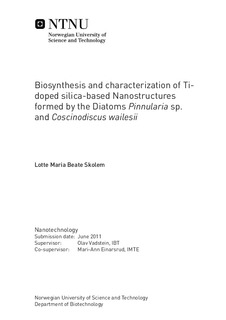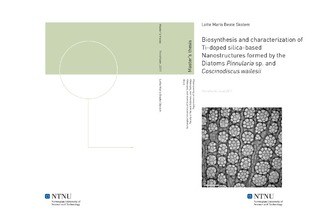| dc.description.abstract | The metabolic insertion of titanium into the biosilica frustules of the pennate diatom Pinnularia sp. and the centric diatom Coscinodiscus wailesii was explored in the present study. A total of five titanium incorporation experiments were conducted on Pinnularia, in addition to five control experiments. Titanium dissolved in HCl was co-delivered with silicate dissolved in NaOH to silicate replete and silicate deplete Pinnularia cultures over a 10 hour delivery period. Cell number, silicate and titanium concentration, Quantum Yield, Instantaneous Chlorophyll Fluorescence and pH was measured regularly throughout the experiments. The diatoms were left to consume the delivered silicate/titanium for 62 hours after delivery was completed before they were harvested and rinsed to remove the organic material. The resulting biosilica frustules were analyzed with (Scanning) Transmission Electron Microscopy to investigate the frustule structure, Inductively Coupled Plasma Mass Spectrometry to measure the elemental composition of the frustules and Energy Dispersive Spectroscopy to determine the location of the elements in the frustules. Quantum Yield measurements were conducted to obtain information about the Pinnularia photo system condition, and high Quantum Yield values were interpreted as an indication of a good overall physiological state of the cell. It was found that a combination of high Quantum Yield values and silicate depleted cultures produced the highest titanium content in the Pinnularia frustules (1.3 wt% relative to silicon). Furthermore, EDS analysis revealed that titanium was not evenly distributed throughout the biosilica frustule. The relative titanium content in the Pinnularia frustules was higher in the biosilica at the base of the large pores covering the frustule surface than in the biosilica between the pores. This was in accordance with findings reported in literature. The observed inhomogeneous distribution trend was found to apply also to phosphorous and iron present in the titanium-doped frustules. This observation has not been previously reported.Cell aggregation of the Pinnularia cultures was observed upon silicate/titanium addition. Based on results from control experiments there was reason to believe that the aggregation was triggered by titanium, but the explanation for this cellular response as well as its effect on titanium uptake and incorporation was not determined. Three titanium incorporation experiments were conducted in the proof on concept study on Coscinodiscus . Titanium dissolved in HCl and silicate dissolved in NaOH was co-delivered with a pipette once a day for three, five and seven days. On the day following the final addition, the diatoms were harvested and rinsed before they were analyzed in the same manner as Pinnularia. The experiments on Coscinodiscus revealed that metabolic insertion of titanium into the frustule biosilica was possible, but due to the small maximal titanium content achieved (0.03 wt% relative to silicon) and the slow growth rate, Coscinodiscus was not considered an optimal choice of diatom species for titanium incorporation purposes.It was not possible to rule out whether the frustule structure in any of the two species had been altered or impaired as a consequence of titanium exposure. Structural flaws were observed in frustules with and without titanium incorporated. A faint irregular pattern on the nanoscale was observed in Pinnularia frustules containing titanium. No such pattern was observed in titanium free frustules.The amount of boron measured in the frustule biosilica was higher than the regular dopant concentration in boron-doped silicon. The boron content in Pinnularia was found to be on average 0.1 wt% or 0.28 atomic % relative to Si, while the average in Coscinodiscus was nearly twice as high. Without further manipulation, this high boron natural boron concentration makes diatom frustules unusable for doped semiconductor purposes.Future work should involve reproduction of the obtained results with more replicates, as well as larger culture volumes and, in the case of Coscinodiscus in particular, longer time scale. Titanium uptake and incorporation studies should if possible be performed on single Coscinodiscus cells. Multiple continuous silicate starvation and titanium/silicate delivery cycles should be tested to determine if it is possible to incorporate titanium into a larger fraction of the culture population, as well as to increase the maximum amount of titanium incorporated into one frustule.Aggregation of Pinnularia diatoms should be further investigated to determine reason for the observed reaction, the effects on titanium uptake/incorporation and possible strategies to prevent it from occurring. Pinnularia frustules unexposed to titanium should be inspected in order to determine if the iron and phosphorous distribution pattern observed in the titanium-doped frustules is present in titanium-free frustules as well.A completely artificial culture medium and plastic cultivation containers should be applied to explore how the boron content of diatom frustules can be tailored by controlled delivery of boron to the culture medium. | nb_NO |

